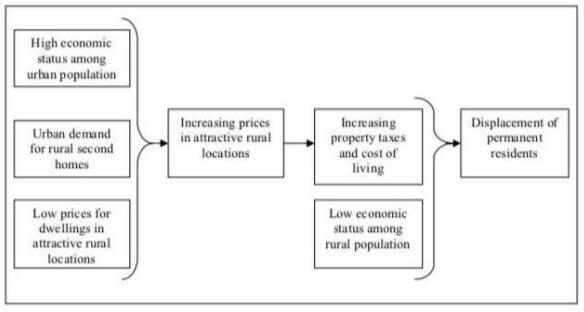Cape Crisis 101: The Facts
As Cape Cod's economy has moved away from local industries like fishing and farming, we have become increasingly reliant on the money of tourists, summer people, second homeowners, and retirees. This transformation has brought a whole host of problems to the Cape, including a monumental housing crisis, high rates of opioid overdose fatalities, rapidly accelerating suburbanization and gentrification, and mass environmental devastation. It's time to acknowledge tourism and the second home industry have done more harm than good. The majority of Cape Codders will never see any financial or quality-of-life benefits from these systems. The Cape Cod DSA believes that the immediate prioritization of the Wampanoag community, year-round locals, the Cape's environment, our long-term sustainable industries, and the return of a year-round economy is the only solution. We must take action before it's too late to save our community.

49% of jobs on Cape Cod exist to serve tourists.
Cape Cod has higher unemployment and lower income than the rest of the state.
One acre of land on Cape Cod increased in price from $500 to $50,000 from 1940 to 1975.
Cape Cod is home to 50% of Massachusetts’s second houses, and 72% of these stand empty for the majority of the year.
In a survey of second homeowners on Cape Cod, 70% had a pre-tax income of $100,000 or more.
41% of all houses on Cape Cod are seasonal or occupied part-time.
As of September 2015, Cape Cod needed “up to 87%” nitrogen reductions.
According to some studies, as of 2016, there are 80% less cod in the Gulf of Maine than in 2006, around 6% of a healthy population.
1 in 13 people on Cape Cod are struggling with alcohol addiction, while 1 in 32 are struggling with addictions to either opioids or heroin.
Cape Cod has higher fatality rates than the state of Massachusetts for both alcohol and drug addictions.
From 2004-2014, 20% of Cape Codders who died from opioid-related causes were between 18-29. The rest of Massachusetts sees a opioid overdose rate of 2% for this age bracket.
65% of victims of fatal opioid overdoses on Cape Cod from 2004-2014 worked in trade or service.
The United States government violated its own Indian Non-Intercourse Act of 1790 by annexing Mashpee without Congressional permission.
The Cape’s property tax rate is just 0.776%. The Massachusetts average is 1.21%.
Almost 85% of Cape houses still use on-site septic systems to filter our waste, which don’t remove nitrogen and it goes straight back into the ocean.
Nearly 400 Cape Codders are homeless, and this number continues to rise.
25% of second homes are owned by a Trust, LLC or group.
SOURCES:
Analysis of Substance Abuse on Cape Cod: A Baseline Assessment; Cape Cod: The Environment, the Economy and the People of a Fragile Eco-system; Cape Cod Second Homeowners: Technical Report of 2017 Survey Findings;
EPA PRESS RELEASE: EPA Approves Massachusetts Plan to Protect Cape Cod Waters; Help! Wanted: Cape Cod's Seasonal Workforce; Housing the Cape's Workforce: More Year-Round Rentals for a Stronger Economy; A Milestone in the War Over the True State of Cod; Seaweed's Revelation by Amelia Bingham; “Massachusetts Property Tax Calculator”; Regional Planning for a Sustainable America: How Creative Programs Are Promoting Prosperity and Saving the Environment by Carlton K. Montgomery
So, what next?
The Cape Cod DSA believes that it's time to put locals first.This means getting our neighbors in houses, keeping our youth on the Cape, and looking out for each other. This means respecting and defending Wampanoag land sovereignty. This means restricting second home ownership, tourism, overdevelopment, and fighting short-term rentals and industries like AirBnB that hurt our community. This means putting our environment first and fighting to end needless teardowns and deforestation while vacation homes stand empty all around us.This means locals are ready to fight back.
CCDSA on Instagram
Our Twitter
Join us
